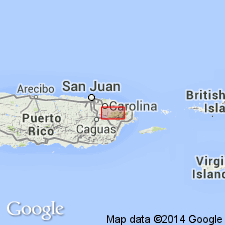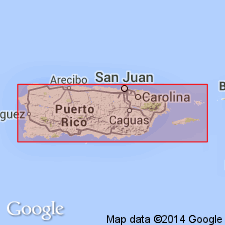
- Usage in publication:
-
- Infierno Formation*
- Modifications:
-
- Named
- Dominant lithology:
-
- Lava
- Volcaniclastics
- Mudstone
- AAPG geologic province:
-
- Caribbean region
Summary:
The Infierno Formation, here named, was mapped as the Santa Olaya Lava by Pease (1968). Consists of andesitic to basaltic lavas, volcaniclastic rocks, and mudstones. Overlies the Hato Puerco Formation; underlies the Celada Formation. Age is Late Cretaceous (Turonian).
Source: GNU records (USGS DDS-6; Reston GNULEX).

- Usage in publication:
-
- Infierno Formation*
- Modifications:
-
- Overview
- AAPG geologic province:
-
- Caribbean region
Summary:
The Infierno Formation occurs in eastern Puerto Rico and consists of pillowed, basaltic andesite lava, volcanic breccia, volcaniclastic sandstone, and mudstone. Maximum thickness is 900 meters. The Infierno is of Late Cretaceous age.
Source: GNU records (USGS DDS-6; Reston GNULEX).
For more information, please contact Nancy Stamm, Geologic Names Committee Secretary.
Asterisk (*) indicates published by U.S. Geological Survey authors.
"No current usage" (†) implies that a name has been abandoned or has fallen into disuse. Former usage and, if known, replacement name given in parentheses ( ).
Slash (/) indicates name conflicts with nomenclatural guidelines (CSN, 1933; ACSN, 1961, 1970; NACSN, 1983, 2005, 2021). May be explained within brackets ([ ]).

